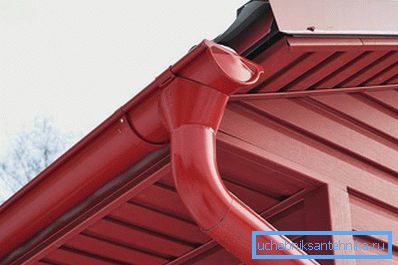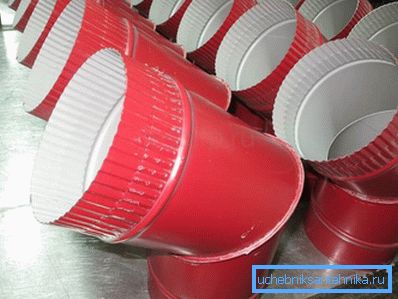How to choose roof drains
Choosing a drainage system, you will have to give preference to either plastic or metal drains. They differ little in their aesthetic characteristics, but during operation, various advantages and not always pleasant nuances can be identified. Let's compare the plastic and metal drainage systems, note their qualitative differences, advantages and disadvantages, features of choice in other parameters: cost, roof area, etc.
Advantages and disadvantages: plastic or metal
First of all, it is necessary to note the pros and cons of the materials from which the gutters are made - this is plastic and metal. Having understood this, you can halve the number of options.

So, plastic roof drains are different:
- aesthetic appearance;
- less noise compared to metal systems;
- a variety of colors and shapes;
- smooth surface, thanks to which there are no obstacles to the flow of water;
- less weight;
- lack of chemical reaction with water;
- ease of installation;
- lower cost.
The main drawback of plastic drain is that it does not tolerate high and low temperatures: under the scorching sun it can melt and become too elastic, which will cause it to deform, in the cold plastic becomes too fragile and can be damaged by a large piece of ice coming down from the roof.

If we talk about metal systems, then among the advantages especially should be highlighted:
- significant resistance to mechanical stress;
- maintaining performance over a wide range of temperatures - from -60 to +130 degrees;
- fire resistance.
The disadvantages for some will be significant. It:
- considerable weight of the structure, which is why it is impossible to carry out their installation on light roofs;
- noisy;
- metal corrosion in case of damage to the polymer layer;
- high cost;
- complex installation;
- narrow color range;
- need constant care.
In fairness, I must say that the metal gutters are made of different metals: steel, aluminum, copper, aluzinc, titanium-zinc, and therefore their characteristics are somewhat different.

Copper is generally considered the best material for drains for several reasons: it looks great, does not give in to corrosion, is durable. On the surface of the aluminum film is formed, which is an aluminum oxide, it protects the metal from the aggressive effects of water and does not allow corrosion to occur. Steel coated with polymers or zinc. In itself, it reacts with water, i.e. rusting, but the coating avoids this. Titanium zinc is a durable material, but contact with iron and copper should not be allowed. Aluminum zinc combines the best qualities of aluminum and zinc, drains from this material are 2-3 times more resistant to corrosion.
About quality of galvanization and polymer layer of metal systems
The service life of metal drainage directly depends on the quality of galvanizing, so it is important to pay a little attention to this aspect. There are only 4 classes of galvanizing: 1, 2, 3 and elevated. Optimal characteristics have a drain first class galvanizing, i.e. on 1 m2 surface accounts for 275 grams of zinc. Those samples where the indicator is less than 142.5 g / m2, just not to choose.
The polymer layer gives color to the drain. However, it is more important to decide on the choice of polymers: polyester or polyurethane. Polyurethane is more resistant to mechanical stress, it is not so easy to scratch it to the metal, but polyester is easily affected. Without a protective coating, the steel will begin to corrode.

In addition, polyurethane is much more resistant to UV exposure. This indicator is denoted by the abbreviation RUV. In total, there are 4 degrees of stability. Polyurethane is assigned the maximum - RUV4, which means that there is practically no change in color. Polyester usually corresponds to the penultimate - RUV2, i.e. in the sun the drain will fade very noticeably. But polyester has two significant advantages:
- availability;
- lower cost.
Be careful when installing, do not damage the protective layer.
Criteria for the selection of drains: thickness, shape, diameter, sealing
Thickness
The strength of gutters and pipes is largely determined by the thickness of the product. The thicker the material, the stronger. Depending on the material, the optimum thickness will be:
- Plastic - from 2.2 to 3.3 mm.
- Steel - from 0.5 to 0.7 mm.
- Aluminum - from 1 to 1.5 mm.
- Zinc-titanium - more than 0.6 mm.
- Copper - from 0.55 to 0.9 mm.
The form
Drainage systems can be of different forms:
- round;
- rectangular;
- figured.
Round drains are installed most often, but sometimes they choose both rectangular and figured versions. Their purpose is often aesthetic. Although it should be noted, and some technical features.

For profiled pipes, special fasteners are needed, and the installation itself will be more difficult to carry out yourself. When installing use sealant and rivets. Otherwise, fix the drain to the wall of the building, because for rectangular pipes require more durable fasteners. All other things being equal, the area of a rectangular section will be 30% larger than the area of a round one, which means that the throughput of the profile pipes is higher. From this it follows that with the same throughput of a rectangular and round drain of material, the production of the first will be less, which means it will cost less. In addition, rectangular gutters are more resistant to rupture when water freezes inside, which is explained by the feature of the section shape.
Figured gutters give an interesting look to the facade of the building, but it must be borne in mind that the water through these drains is slower.
Diameter of pipes and gutters
Having decided on the other characteristics, it will be necessary to choose the optimal diameter of gutters and pipes. It depends on the total area of the roof. Calculating this parameter, determine the area of all the roof slopes, and then fold the area. There are no difficult moments. You can navigate by the table.

Sealing compounds
Sealing compounds gutters carried out with rubber seals or glue.
Rubber seals. Provide easy installation. Installation can be carried out even at sub-zero temperatures. However, they can lose their elasticity, shatter in the sun.
Glue. The installation is more complex, impossible in the cold, but the connection is more tight.
Carefully choose the drainage system, not losing sight of any parameter. Make an informed choice.